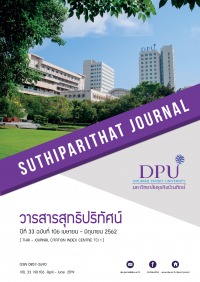THE INFLUENCES OF MOTIVATION AFFECTING TO SPORT TOURISM ACHIEVEMENT AT PHUKET: A CASE STUDY OF EVENT MARATHON
Keywords:
Motivation, Experience Marketing, Perceived Value, Sport Tourism AchievementAbstract
The purposes of this study were (1) to study the level of influence the form of motivation for sport tourism on achievement sport tourism and (2) to examine the relationship of the causal model and the impact of motivation on achievement sport tourism (Satisfaction, Revisit and Word-of-mouth). This study was quantitative research that used questionnaire for collecting data. The samples were 400 participants of event marathon in Phuket. Using descriptive statistics, the data collected were analyzed by using the percentage, mean and standard deviation. Structural equation modeling (SEM) analysis was conducted to test the hypotheses of the structure.
Results of structural equation modeling indicated that the motivation had impact on experience marketing, perceive value and sport tourism achievement. The experience marketing had impact on perceive value and sport tourism achievement. Also, perceived value had the impact on sport tourism achievement. These findings were statistically significant at 0.01.
References
กองเศรษฐกิจการท่องเที่ยวและกีฬา. (2560). โครงการพัฒนารูปแบบทางธุรกิจของการท่องเที่ยวเชิงกีฬาของไทย. กรุงเทพฯ: กระทรวงการท่องเที่ยวและกีฬา.
การท่องเที่ยวแห่งประเทศไทย. (2551). วิเคราะห์ศักยภาพของอุตสาหกรรมการท่องเที่ยวของประเทศไทย. กรุงเทพฯ: กองวิชาการ การท่องเที่ยวแห่งประเทศไทย.
กัลยา วาณิชย์บัญชา. (2549). การใช้ SPSS for Windows ในการวิเคราะห์ข้อมูล. กรุงเทพฯ: ธรรมสาร.
เกศสิรี ปั้นธุระ. (2554). การรับรู้คุณค่าและการตั้งใจซื้อซ้ำของผู้บริโภคต่อสินค้าอาหารโอทอป. พัฒนบริหารศาสตร์, 53(3), 201-230.
บีทีแอลบางกอก. (2561). ท่องเที่ยวไทยสดใส กวาดรายได้แตะ 1 ล้านล้านบาท. สืบค้น 30 กันยายน 2561, จาก http://www.bltbangkok.com/News.
แบรนด์อินไซด์. (2560). วิ่งเพื่อสุขภาพ เทรนด์มาแรงหยุดไม่อยู่ จัดกว่า 600 รายการต่อปี มูลค่ารวมกว่า 1 หมื่นล้านบาท. สืบค้น 30 กันยายน 2561, จาก https://brandinside.asia/running-for-healthand-Business.
พศกร ผ่องเนตรพานิช. (2559). ปัจจัยที่มีผลต่อความตั้งใจซื้อบริการฟังเพลงออนไลน์ของผู้ใช้สมาร์ทโฟนในประเทศไทย. วารสารวิชาการมหาวิทยาลัยกรุงเทพ, 15(2), 69-84.
ภัทรพร ทิมแดง, และวินัย ปัญจขจรศักดิ์. (2554). โมเดลการตลาดเชิงประสบการณ์ของนักท่องเที่ยวชาวต่างชาติ. วารสารสมาคมนักวิจัย, 16(3), 89-101.
Anderson, E. W., Fornell, C., & Lehmann, D. R. (1994). Customer satisfaction, market share, and profitability. Journal of Marketing, 58(3), 53-66.
Boksberger, P. E., & Melson, L. (2011). Perceived value: a critical examination of definations, concepts and measures for the service industry. Journal of services Marketing, 25, 229-240.
Changlin, W. (2014). Antecedents and consequences of perceived value in mobile government continuance use: An empirical research in China. Computers in Human Behavior, 34, 140–147.
Cochran, W.G. (1977). Sampling techniques (3rd ed.). New York: John Wiley and Sons.
Cohen, J., & Uphoff, N. (1977). Rural development participation: Concepts and measures for project design, implementation and evaluation. Ithaka: Cornel University.
Comrey, A. (1973). A first course on factor analysis. London: Academic Press.
Cortina, J. M. (1993). What is coefficient alpha: An examination of theory and applications. Journal of Applied Psychology, 78(1), 98-104.
Hritz, N., & Craig, R. (2010). The perceived impacts of sport tourism: An urban host community perspective. Journal of Sport Management, 24, 119-138.
Iso-Ahola, S.E. (1982). Toward a social psychological theory of tourism motivation: a rejoinder. Annals of Tourism Research, 9, 256-262.
Jones, M.A., & Suh, J. (2000). Transaction-specific satisfaction and overall satisfaction: An empirical analysis. The Journal of Services Marketing, 14(2), 147-159.
Kim, J. (2013). A cross-cultural comparison of memorable tourism experiences of American and Taiwanese college students. Anatolia: An International. Journal of Tourism and Hospitality Research, 24(3), 1-15.
Kitapcl, O., Akdogan, C., & Dortyol, T. (2014). The impact of service quality dimension on patient satisfaction, repurchase intentions and word-of-mouth communication in the public healthcare industry. Procedia-Social and Behavioral Sciences, 148, 161-169.
Kline, R. B. (2010). Principles and practice of structural equation modeling (3rd ed.). New York, NY: The Guilford Press.
Kwortnik, R. J., & Ross, W. T. (2007). The role of positive emotions in experiential decisions. International Journal of Research in Marketing, 24(4), 324-335.
Lau, L., & McKercher, B. (2004). Exploration versus acquisition: A comparison of first-time and repeat tourists. Journal of Travel Research, 42(3), 279-285.
Lee., J.E. (2018). Effects of price discount on consumers’ perceptions of savings, quality, and value for apparel products: Mediating effect of price discount affect. Retrieved October 31, 2018, from https://link.springer.com/article/10.1186/s40691-018-0128-2.
Mcintosh, W. R., & Goeldner, C. R. (1990). Tourism: Principles, practices, philosophies (6th ed.). New York: Wiley.
Nurcahyo, B. (2016). The role of customer satisfaction in a relation of experiential marketing and customer loyalty. Advances in Social Sciences Research Journal, 3(1), 78-89.
Poulsson, S.H.G., & Kale, S.H. (2004). The experience economy and commercial experiences. Boston: Harvard Business.
Rittichainuwat, B.N. (2002). A study of the impact of travel satisfaction on the likelihood of travelers to revisit Thailand. Journal of Travel and Tourism Marketing, 12(2/3), 19-42.
Sharpley, R. (2006). Travel and tourism. London: Sage Publications.
Schumacher, R. E., & Lomax, R. G. (2010). A Beginners Guide to Structural Equation Modeling: SEM. New Jersey: Lawrence Erlbaum Associates.
Solomon, M.R. (2004). Consumer behavior: Buying, having and being. Upper Saddle River. NJ: Pearson Education International.
Srivastava, M., & Kaul, D. (2016). Exploring the link between customer experience loyalty consumer spend. Journal of Retailing and Consumer Services, 31, 277-286.
Treesuwan, A. (2010). Study of Thai tourists’ characteristics in traveling to Korea. Veridian E–Journal, 3(1), 232-244.
Wang, S.T.E. (2013). The influence of visual packaging design on perceived food product quality, value, and brand preference. International Journal of Retail & Distribution Management, 41(10), 805-816.
Yiannakis, A. (2002). Tourist roles: Needs and the adult life course. Annals of Tourism Research, 29(1), 323-343.
Downloads
Published
How to Cite
Issue
Section
License
Content and information of the article published at Suthiparithat Journal are based on the sole opinions and responsibility of author(s) only. Neither the editorial board involve in......







